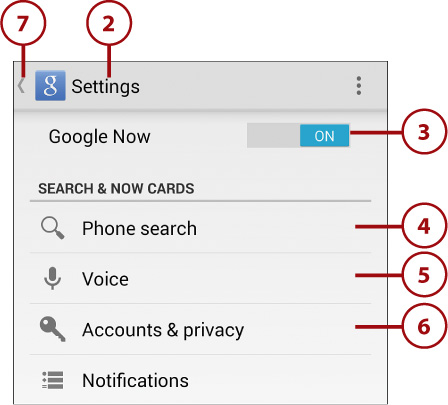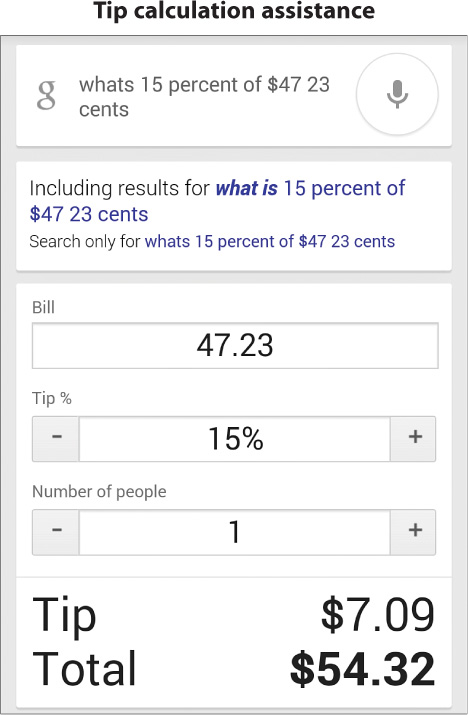15. Using Voice Services
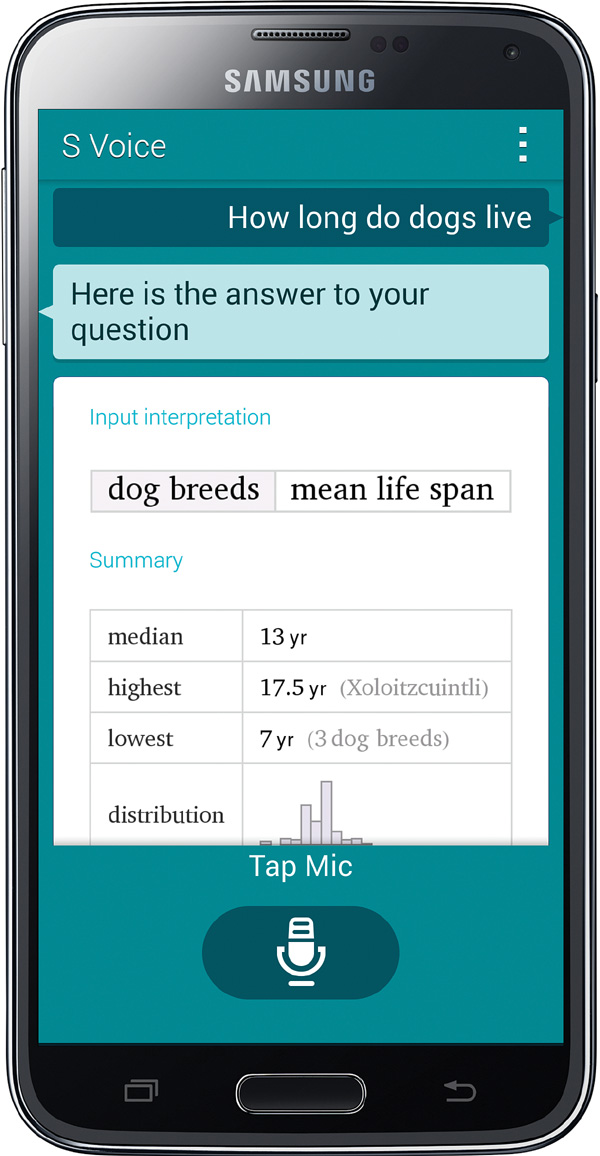
In this chapter, you learn about controlling your Galaxy S5 using voice commands. Topics include the following:
![]() Using and configuring Google/Voice Search
Using and configuring Google/Voice Search
The Galaxy S5 ships with a pair of competing voice-command apps: S Voice (a Samsung app) and Google/Voice Search. Both operate in a similar fashion, enabling you to speak English-like commands and queries to control the phone and its apps, perform Web searches, and find answers to your questions.
Using S Voice
S Voice is a voice app that enables you to ask questions in natural language (“Where can I find pizza?”) and command the phone (“Open Calculator”). The result may be a direct answer, a Web search, launching an app, or performing a specific command within an app.
1. Launch S Voice by tapping Apps, S Voice or by double-tapping the Home key.

Using the Home Key
If double-tapping the Home key doesn’t launch S Voice, tap Apps, S Voice; tap the menu icon and choose Settings; and then enable Open Via the Home Key. On subsequent uses, double-tapping the Home key will work properly. To learn more about S Voice settings, see the “Configure S Voice” task later in this chapter.
2. The S Voice screen appears. Say your first question or command. For example, you might ask, “What’s the weather like today?” to see the weather forecast for your city. S Voice displays the information it finds.
3. To ask S Voice the next question or give it a new command, tap the microphone button or say the wake-up phrase. (“Hi, Galaxy” is the default phrase.)
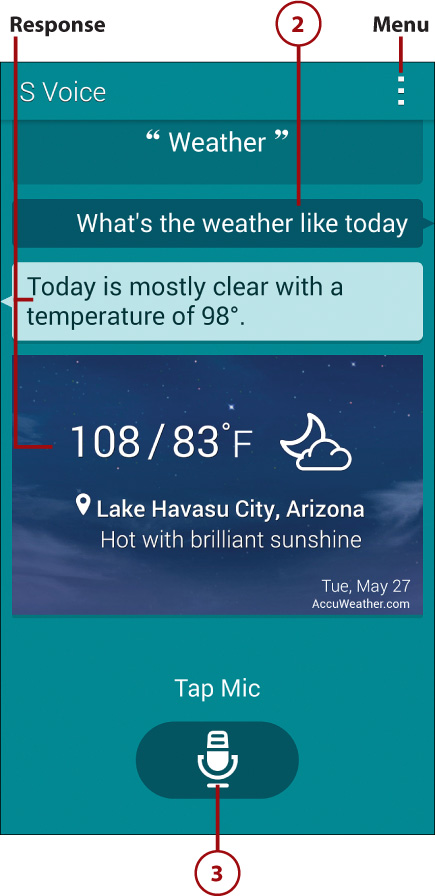
Help with S Voice Commands
If you want assistance with question and command phrasing, say “Help,” or tap the menu icon and choose Example Commands.
Commanding the Phone
When using S Voice to control the phone or specific apps, there are some important commands you need to know and S Voice limitations of which you should be aware. In addition to the ones presented in this section, you’ll discover other general and app-specific commands and limitations as you experiment.
First, if you leave the S Voice screen, you typically lose the ability to issue further commands—until you return to S Voice. This happens, for example, when you issue an Open app command. If you need to perform specific functions within the app, you have to do so manually or figure out if there’s a way to issue a more complex command from S Voice. Instead of saying “Open Music,” you might say “Play Black Oak Arkansas” (a group) or “Play Maxwell’s Silver Hammer” (a song), for instance.

Second, in some circumstances, S Voice prompts you for missing details in order to complete a command or clarify what you want. For example, if you say “Create new event Shop for trombone,” S Voice asks for a time (because you’ve requested a new event rather than a task) and then asks whether you want to save it to Calendar.
Third, when buttons are displayed (such as Cancel and Save), you can tap or speak the button name to indicate how the current item should be handled. Alternatives, such as saying “Yes” or “No,” are often acceptable, too.
Fourth, you can back out of or halt many commands by saying “Cancel.”
To get you started, review some of S Voice’s supported commands by opening the menu and choosing Example Commands. Here are some others you can use:
• Launching apps. To open an app, you can say “run,” “open,” “launch,” or “start,” followed by the app’s name. After you finish using the app, you can frequently return to S Voice by pressing the Back key repeatedly until you exit the app.
• Controlling settings. Sadly, there are only a few system settings that you can command. You can enable or disable Wi-Fi or Bluetooth by saying “Turn on (or off) Bluetooth,” “Enable (or disable) Wi-Fi.” Because Settings is an app, you can open it by saying “Open Settings.” You can also change the current volume by saying “Volume up (or down)” or “Raise (lower) volume.”
I Can’t Find a Network Connection
If Mobile Data (in Data Usage Settings) isn’t enabled when you turn off Wi-Fi, you won’t be able to turn it back on with a voice command. In fact, you won’t be able to use S Voice at all because it requires an active Wi-Fi or cellular connection. To resume using S Voice, manually enable Wi-Fi by tapping its Quick Setting button or open Settings, tap Data Usage, and enable Mobile Data.
• Safer navigation. Open the Notification panel and enable Car mode by tapping its Quick Setting button. A version of S Voice with huge text and icons launches.
• Calculations. Rather than launch Calculator, speak the calculation that you want to perform. Examples include “472.43 divided by 17.6,” “Multiply 6 by 17.5,” “Square root of 87.5,” “Minus 6.5 times 8,” “What is three-fourths of 17.65?,” and “Calculate 15% of $84.35.”
Calculation Difficulties
It can be difficult discovering acceptable phrasing for calculation commands, and many such commands can’t be answered—even when S Voice shows that it understands the numbers and operators. For example, I couldn’t find a way to multiply by a number less than one (such as 18 * 0.12) other than to state the decimal number as a fraction: “18 times 12 divided by 100.”
• Units of measure and currency conversions. Examples include “How many pints in a liter?” “How many millimeters in a yard?” “How many British pounds can I get for $14?” and “Convert dollars to yen.”

• Just-for-fun commands and queries. Try asking/saying the following: “How much wood could a woodchuck chuck if a woodchuck could chuck wood?” “Sing,” “Where is Carmen Sandiego?” “What’s the ultimate answer to life, the universe, and everything?” and “Tell me a joke.”
What About Web Searches?
Like Voice Search (discussed later in this chapter), S Voice can perform Web searches. In fact, when it doesn’t hear you clearly or can’t determine what you want, it offers to search the Web. Interestingly, when you do request a search, the request is often handed off to Google Search.
Commanding Apps: Calendar
In addition to merely launching apps, you can use S Voice to issue commands to some of them. As an extended example, here are some ways that you can control Calendar.
You can give voice commands to schedule new appointments (events) or tasks. Examples of creating new tasks include: “Create new task give Jethro a bath next Sunday,” “New task install vertical blinds” (when no date is provided, S Voice assumes the task’s due date is today), and “Create task wash car on Saturday reminder on Friday” (adding “reminder on...” instructs Calendar to present a reminder notification on the specified day). Another way to add a reminder is to include a time in the command, such as “New task take out garbage tonight at 10:00 p.m.” Although tasks don’t have scheduled times (only events do), the mention of 10:00 p.m. is interpreted to mean that you want to be reminded at that time.
Scheduling appointments works in much the same way, but events contain additional components. You might say, for example, “Schedule operation at hospital for 7:00 a.m. Wednesday for 4 hours.” Because it includes all essential details for a new appointment, S Voice offers to save it as-is. If it’s lacking an important element (such as the time), S Voice prompts for it. When asked, you can specify both the time and date, such as “Saturday at 11:30 a.m.”
To view a list of your upcoming tasks or events, you can say “Show my tasks” or “Show my appointments.” Each command results in a list, but appointments are read aloud.
Deleting and Editing Tasks and Events
To delete upcoming or recent tasks and events without launching Calendar, you can say “Delete task (or appointment).” S Voice presents a list of tasks or events, asks you to specify the one to delete, and then asks you to confirm the deletion.
You can also be more specific, such as “Delete wash car.” If there are multiple instances of a wash car task, S Voice lists them and asks which one to delete. You can select an item by position by saying “the second one,” for example.
If you notice an error in a saved appointment or event, say “Edit appointment (or task).” S Voice asks you to select the appointment or task to edit and then prompts for the change(s).
1. In S Voice, tap the menu icon and choose Settings.

2. The Settings screen appears. Following are some of the most important S Voice settings.
3. Open Via the Home Key. When enabled, you can launch S Voice by double-pressing the Home key from almost anywhere on the phone.
4. Voice Wake-up. When Voice Wake-up is enabled and S Voice is onscreen, you can speak a phrase (such as “Hi, Galaxy”) to get the app’s attention; otherwise, you must tap the microphone icon. Tap this item to enable, disable, or change the wake-up command.
5. Auto Start Speakerphone. When this option is checked and you instruct the Phone app to place a call, Speakerphone mode is automatically enabled.
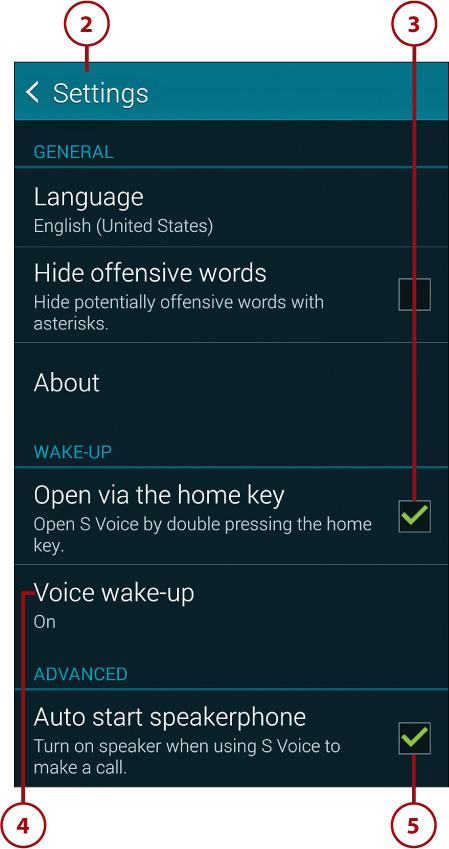
6. Show Body of Message. When a text message arrives, S Voice can display the message body (checked) or only the sender’s name (unchecked). If the latter option is chosen, you can ask S Voice to read the hidden message text aloud.
7. Check Missed Events, Personal Briefing. When enabled, missed events and/or your schedule are displayed when you first launch S Voice.
8. Home Address. Tap this setting to record your home address, enabling S Voice to use it to generate responses to you.
9. Log In to Facebook, Sign In to Twitter. If you want to use S Voice to post to a Facebook or Twitter account, you must log into your account(s)—enabling S Voice to do so in later sessions. When enabled, you can say commands such as “Facebook update Has anyone seen the new Godzilla movie?” If the appropriate app isn’t already installed, you’ll be taken to the appropriate Google Play page to download and install it.
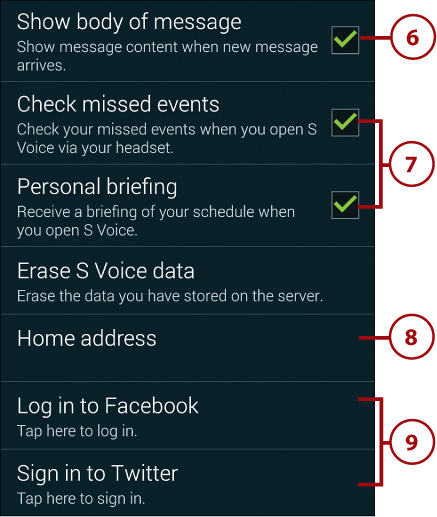

Using Google/Voice Search
Google, Voice Search, and Google Now are interrelated apps. As a result, you can perform several different launch actions to end up in the same place; that is, ready to issue voice commands and requests.
1. Launch Google/Voice Search by doing one of the following:
• Tap Apps, Google or Apps, Voice Search.
• With the Google Search widget displayed on the current Home screen, tap the widget or say “OK, Google.”

2. The opening screen that appears depends on whether Google Now is enabled (see “Configuring Google/Voice Search,” later in the chapter) and the launch method used in Step 1.
3. If the screen doesn’t automatically request your voice input, tap the microphone icon or say the wake-up phrase (“OK, Google”).
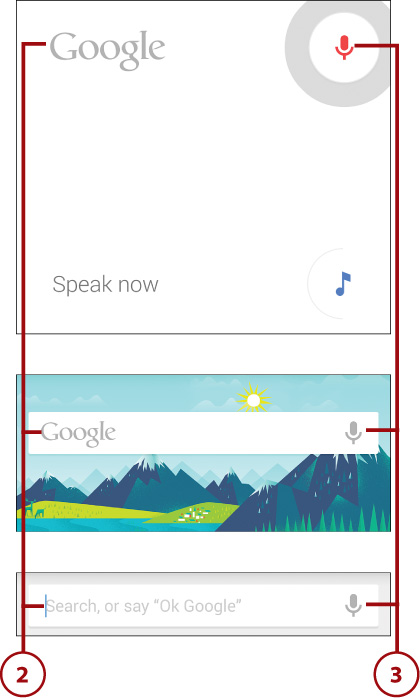
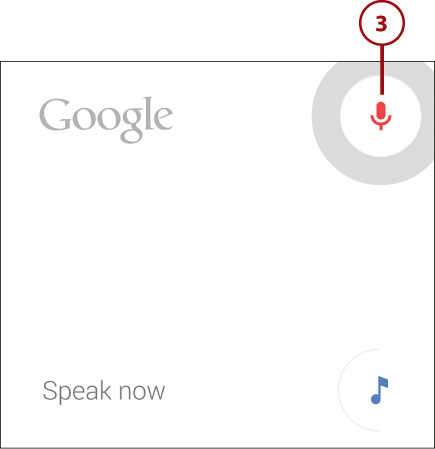
4. Speak a voice command or search request.
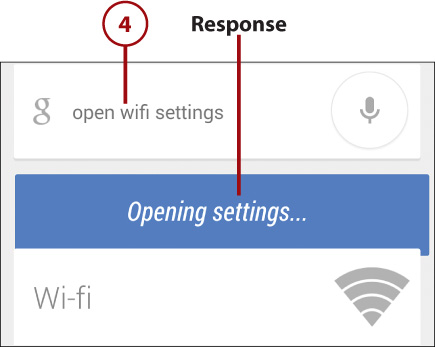
5. Depending on the nature of your voice input, an app, web page, or Settings screen opens (taking you to a different screen) or the result is displayed on the Google screen. If you want to issue more commands or requests, do the following:
• If you’re still on the Google screen, tap the microphone icon or say “OK, Google,” and then issue your new command or request.
• If a different app or a Settings screen is onscreen, press the Back key until you reach the Google screen, or press the Home key and start over again at Step 1.
Configuring Google/Voice Search
After familiarizing yourself with the Google/Voice Search capabilities, you should review its settings.
1. On the Google, Voice Search, or Google Now screen, open the menu in the lower-right corner and choose Settings. (If you can’t see the menu, you can also open it by long-pressing the Recent Apps key.)

2. The Settings screen appears. Following are some of the most important Google/Voice Search settings.
3. Google Now. You can enable or disable Google Now by changing the position of the switch. (This setting has no bearing on the manner in which voice commands and search requests are performed.)
4. Phone Search. Checked items specify the types of information on your phone that will be examined when performing voice searches and commands. Generally, you’ll want to leave all of these content areas checked.
5. Voice. These settings enable you to change the input language, specify whether Google responds audibly (Speech Output enabled) or only in text, whether it activates in response to the wake-up phrase (“OK, Google”), and whether it recognizes input from a Bluetooth headset.
6. Accounts & Privacy. The only setting that has a significant effect on voice commands and searches is Contact Recognition. When checked, Google uses your Contacts records to determine who you’re trying to reach when calling people or creating text messages and email, for example.
7. When you’re done viewing and changing settings, press the Back key or tap the Back icon.
